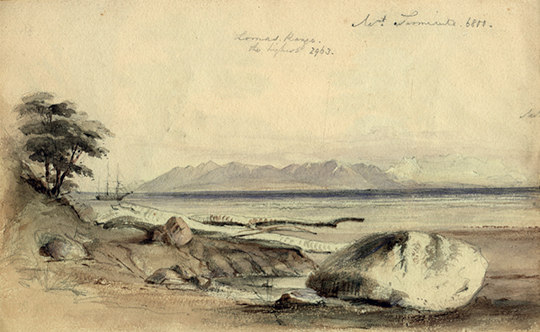
[Image] Courtesy of University of Cambridge Digital Library
In September 1833, Charles Darwin set out for the four peaks of the Sierra de la Ventana alone, lured by local murmurs of caves and forests and veins of silver and gold. The small range was barely visible from the port of Bahia Blanca, a notch in the north-central Argentine coast. There, the H.M.S. Beagle remained docked with Captain Fitzroy, who had invited Darwin aboard the ship to circumnavigate the globe as a scientist.
After an arduous series of climbs up shattered, ash-grey rock, Darwin reached the first and second summits by early afternoon. As he looked out from the heights in the early Argentine spring, his gaze would have likely met with soft, dun waves of grassland, dotted with swallows, stretching out toward the ocean. Nonetheless, he wrote, “I was…disappointed with this ascent. Even the view was insignificant;–a plain like the sea, but without its beautiful color and defined outline.” The thought of reach ing the remaining two peaks was no longer appealing, for he had already ascertained that the geology did not vary across the small range: he noted only quartz, slate and conglomerate. As Darwin’s experience suggests, the act of summiting peaks sometimes seems to break their enchantments. The distant height of the mountain, drawing your vision upward, invites you to imagine the curvature, the edges, of the unknown. But when a real summit intersects with a fantasized one–should no further, higher peaks exist to draw your eyes up and away again–the topographies of the past, perhaps even the valleys just below your feet, compel your vision back down.
A year after Darwin’s disappointing ascent, while the Beagle sat in Port Famine of Tierra del Fuego, he and a few others set out to climb Mt. Tarn. Their trek began through the thickest woods, which gradually trans formed into a “death-like scene of desolation [that] exceeded all description.” When they finally reached the top, Darwin’s account of the prospect below appears more clinical than aesthetic: “Here was a view characteristic of Tierra del Fuego; irregular chains of hills, mottled with patches of snow, deep yellowish green valleys, and arms of the sea intersect ing the land in many directions.” Only brief glimpses of a “sublime spectacle” appeared when the veils of mist peeled back to reveal the “noble” Mt. Sarmiento nearby. Though Darwin didn’t attempt a climb of the higher peak (a first ascent wasn’t established until 1956), I wonder if he would’ve had the same reaction to its summit vistas.
Later, as he wrote his autobiography, Darwin recalled the impression of thick, tropical flora more keenly than the craggy peaks. Upon returning from the voyage, he had gone back to work on small curiosities, studying barnacles for eight years while developing his grand evolutionary theory. Toward the end of his life, Darwin focused on the still-smaller work of worms that, he believed, produced the earth’s organic crust. I often wonder about the connection of these things: Could Darwin, in turning from the grand to the miniature, be seeking to uncover insight into the infinite that eluded him from the tops of peaks? Perhaps his early alpine disappointments reveal the importance of learning to look down, and carefully–to venture in, at an intimate level, even when we are heading up, to observe steadily the ground beneath our feet.